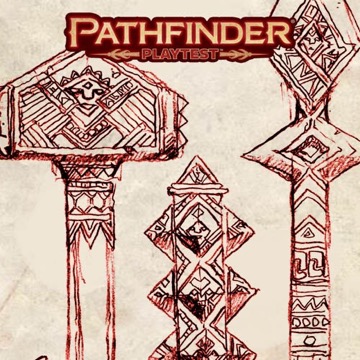For many heroes, their choice of weapon says more about their personality and sense of aesthetics than their penchant for mechanical optimization. For others, form follows function, and still others blend the two. But what sort of weapon fits your personality best? Let's take a look at various weapons and figure it out!
Simple, Martial, or Exotic?
All weapons in Pathfinder are simple, martial, or exotic, based on their rough level of power. Unlike in Pathfinder First Edition, exotic weapons are not just a mixture of powerful European weapons and weapons from other cultures that only occasionally had a leg up over their martial kin. In Pathfinder Second Edition, we have a different way of talking about whether a weapon is likely to be found in a particular region, and so a weapon's type instead describes a weapon's mix of power and flexibility. Simple weapons usually have a smaller damage die than similar martial weapons (d6 rather than d8, for instance), and exotic weapons usually use the same damage die as a martial weapon but include additional abilities that make the weapon more complex.
Characters start with proficiency in either groups of weapons or lists of individual weapons, and they can take ancestry or general feats (and, rarely, class feats) to gain more!
Weapon Traits
Whatever your weapon proficiencies, you'll want to choose a weapon with useful traits that match your taste and play style. Even among martial weapons that use two hands, a bo staff, a greatsword, and a glaive all feel very different.
A greatsword deals a lot of damage, perfect for a bruiser character like a worshiper of Gorum: its damage die is d12 and you can seamlessly switch between piercing and slashing damage to avoid enemy resistances and exploit their weaknesses.
A bo staff is all about controlling the fight. Its damage die is only d8, but it has reach (allowing you to Strike enemies up to 10 feet away), parry (allowing you to spend an action to increase your AC much like a light shield), and trip (giving you several benefits to your attempts to trip enemies). Plus, it has the monk trait, which weapon-wielding monks particularly enjoy.
The glaive has a d8 damage die like the bo staff and shares its reach, but that's where the similarities end. The glaive has deadly d8 (dealing additional d8s of damage on a critical hit), and it is forceful (which means once you get it going and build up momentum, your attacks become more and more powerful: 1 extra damage per die on the second attack of your turn, 2 extra damage for any attacks after that). The glaive-user isn't interested in giving up an action for defense like a character with a bo staff; instead, she does best if she artfully sweeps the blade like a brush, focusing on accuracy and multiple attacks to really dish out the damage—particularly fitting for a follower of Shelyn.
We want to give every weapon a different personality like this so that we can better serve the infinite personalities that players bring with their characters!
Some other fun weapon traits I haven't covered yet: Twin weapons like the saw-toothed saber deal more damage if you fight with two of them. Backswing weapons like the greatclub gain a little accuracy after a miss. Backstabber weapons like the dogslicer deal more damage to flat-footed targets. Agile weapons like the shortsword decrease the penalty for making multiple attacks in a single turn. Finesse weapons like the rapier use your Dexterity modifier for attack rolls if you prefer. Two-hand weapons like the bastard sword deal much higher damage if you wield them in two hands instead of one!

Illustration by Wayne Reynolds
Critical Specialization and Weapon Groups
Traits give us some really cool ways to distinguish weapons, but we decided to throw one more customization factor into the mix, this time for similar groups of weapons: critical specialization effects.
Characters who unlock their weapon's critical specialization effect gain a special bonus effect on a critical hit that's different for each weapon group. For example, let's compare swords, spears, and axes.
Swords make the target flat-footed on a critical hit, making it easier for you and your allies to hit the target again (and making the group's rogue very happy). This cements swords like the greatsword or a longsword as great choices for dealing damage to challenging foes like bosses, as they have high damage and decrease the boss's AC so your team can hit more often.
Spears pierce the target and weaken its attacks. This makes a spear a good option for someone using a more defensive strategy built around negating enemy attacks.
Axes swing to an adjacent target (if any), damaging that target, too! Combined with the fact that axes usually have the sweep trait, giving you a bonus on attacks when you move on to a new target in the same turn, this makes axes extremely well suited for sweeping up groups of enemies.
These are just a few of the possibilities. For instance, daggers can cause persistent bleed damage, and clubs can knock the target up to 10 feet away (particularly amusing on a well-placed Attack of Opportunity).
Weapon Quality
Weapons, as well as other non-weapon items (but come on, those aren't as cool as weapons, right?), can be poor quality, standard quality, expert quality, master quality, or legendary quality.
Quality grants an item bonus or penalty of the same value as the matching proficiency (so an expert bow grants a +1 item bonus to hit and a legendary axe grants a +3 item bonus to hit). You have to have the matching proficiency to Craft a weapon of that quality though, so you can't make a master sword, for instance, unless you are a master at Crafting.
And now you know the basics about weapons! All there is to do now is choose the weapon that suits you. Until next time!
Mark Seifter
Designer







